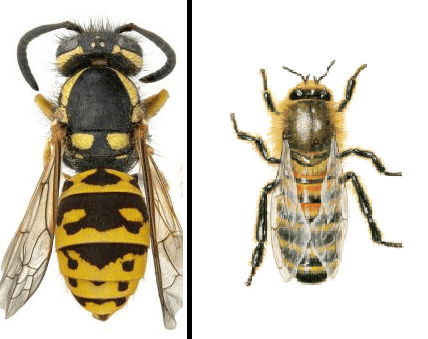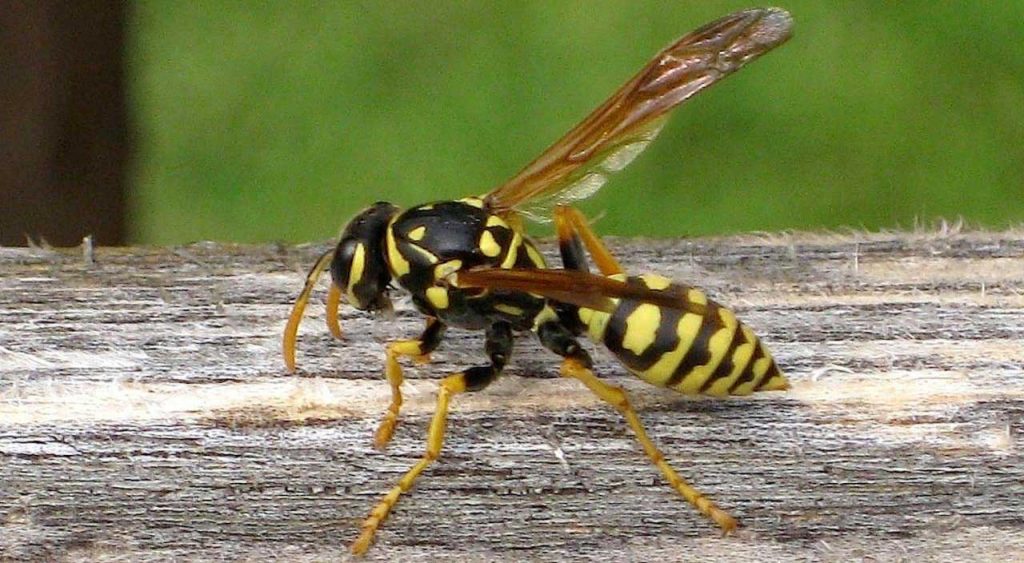Knowing the difference between Yellowjackets and Bees similar pests and working with Shoo Fly Pest Control can make your outdoor eating a much better experience!

First things first….. are they Yellowjackets or Bees?
Honey Bees and Yellowjackets are both common flying insects that are common pests here in Sonoma County. We commonly call both “bees” and to the casual observer they appear similar, but the truth is that they are very different! They both have the same distinct block and yellow pattern, but there are few similarities beyond that.
Honey Bees are an important part of our agriculture, pollinating our vineyards, crops and flowers. Without honey bees (and other types of bees!) we would be unable to grow our food. In the Pest Control industry, and especially at Shoo Fly Pest Control, we work hard to protect the bees in Sonoma County. Our team goes to great lengths to ensure any products applied are done safely and in a way that will not cause harm to the fragile colonies in the area.
Yellowjackets, on the other hand, frequently disturb many barbecues and picnics in Sonoma County. They are persistent pests, going after food and scare us off of our patios and into the house for meals. On the other hand, bees are beneficial insects, pollinating our flowers, gardens and our vineyards throughout Sonoma County. Both are especially common throughout Santa Rosa, Windsor, Healdsburg, Sebastopol and other local areas. Let’s explore and explain a bit more about the important differences between bees and yellowjackets and later look at some best practices to keep the yellowjackets away from our homes!
Appearance:

- Bees: Honey Bees are a smaller and have hairy bodies compared to yellowjackets. While there are many kinds of bees, honey bees are black and yellow and about half and inch long.

- Yellowjackets: Yellowjackets are sleeker and have a smooth, shiny appearance. Yellowjackets are strongly colored black and yellow and have aggressive looking heads!
Other Key Differences:
- Diet and Behavior:
- Bees: Bees collect nectar and pollen from flowers of all kinds. Locally we often see them on our flowers and trees in our gardens here in the Santa Rosa area. They are important pollinators, and are a critical part of the wine growing and agricultural roots we have in Sonoma County.
- Yellowjackets: Yellowjackets are scavengers that primarily feed on proteins and meat. They feed on insects, dead animals, and sugary substances like fruit and other sweets. Locally we think of them more for their annoying presence of going after our food at picnics and barbecues!
- Nesting Habitats:
- Bees: While most bee species are solitary or live in small colonies, honey bees build large complex colonies and hives! They will often nest in cavities, such as hollow trees or occasionally in small gaps in walls. At Shoo Fly Pest Control we have seen several situations in Windsor and Healdsburg where hives have been created inside the walls of a home. This requires cutting into the wall to safely remove the beehive.
- Yellowjackets: Yellowjackets are also socially similar to honey bees that live in large colonies with several classes. They usually live underground and you can find the nests by watching them fly in and out of a small hole in the ground (usually about an inch or two wide). Occasionally you will also find nests in wall voids or similar small openings similar to bee hives.
- Stinging Behavior:
- Bees: Bees are generally not aggressive and will only sting when they feel threatened. The general rule we find with honey bees at Shoo Fly Pest Control is if you leave them alone they will leave you alone! After a sting, a bee’s stinger and a portion of its abdomen is pulled out and left behind at the site of the sting, leading to the bee’s death.
- Yellowjackets: Yellowjackets are more aggressive and more likely to sting. This is most common when they are threatened or disturbed. They can sting multiple times without losing their stinger.
- Ecological Role:
- Bees: Bees play a critical role in pollinating flowering plants. This is an important process for agriculture. Locally we also have the vineyards that are so important in Healdsburg, Windsor, Santa Rosa and all of Sonoma County. They ensure the health of plants and the creation of fruit, that provides food for humans and other animals.
- Yellowjackets: While yellowjackets do have some benefits in nature by controlling insect populations and decomposing animals, their scavenging behavior and aggressive nature can make them a major nuisance and a potential threat to humans, especially in outdoor settings, especially when they ruin your barbecue!
Now that we know the differences between yellowjackets and honeybees, we understand why honey bees are so important that we need to protect them. We also know that yellowjackets can be a major pain any time we want to picnic or eat outdoors! Shoo Fly Pest Control are experts at safely taking care of honey bees and yellowjackets around your home or business. Let’s take a look more closely at yellowjackets and what you can do to make your next barbecue yellowjacket free!
Why Do Yellow Jackets Ruin my BBQ?
Yellowjackets are scavengers and prefer protein based foods. This makes them attracted to barbecues and outdoor picnics. Just like you love a good Sonoma County tri-tip, steak, chicken or fish, the local yellowjackets love them too! They aren’t necessarily picky eaters, and they will go after all types of food, even your sandwiches. There are a few reasons why yellowjackets might be a nuisance around your barbecue:
- Meat and Protein: Meat, fish and chicken are a preferred food source for yellowjackets. The smell of cooking meat can lure them to your barbecue from all around, traveling up to 500 feet from their nest.
- Scents and Odors: Yellowjackets have a keen sense of smell and can smell food from a distance. The delicious smell of cooking food and open containers can attract them to your BBQ area from all over.
- Sugary Foods: Sweet foods like jelly, soda and desserts will also attract Yellowjackets. Leaving these foods out uncovered will draw in yellowjackets.
- Bright Colors and Patterns: Bright colors, especially yellow, which resembles their own markings might also attract yellowjackets. If you’re wearing bright clothing or using brightly colored dishes or containers, it might attract them.
- Open Containers: Leaving food and drinks uncovered can make it easier for yellowjackets to access them. They are opportunistic feeders and will take advantage of any available food sources.
To minimize the presence of yellowjackets during your BBQ, Shoo Fly Pest Control recommends that you consider taking the following precautions. These are easy steps that you can do while you eat to help keep them away from your food.
- Cover Food and Drinks: Keeping all food and drinks covered when they are not being consumed will reduce the scents and visibility that attract yellowjackets.
- Use Sealed Containers: Serve food and beverages in sealed containers to prevent yellowjackets from accessing them.
- Clean Up Spills: Quickly clean up any food or drink spills, as even small amounts can attract yellowjackets. Yellowjackets are opportunistic and any lingering food waste can be an additional feeding site.
- Trash Management: Keep trash cans sealed tightly and away from the eating area. Left over food and food dumped in trash cans are also primary food sources for yellowjackets. Properly disposing of food when you are done eating. At the end of the event, placing all food in appropriate containers, with lids or away from foraging yellowjackets will help.
- Cook indoors: As huge barbecue fans at Shoo Fly Pest Control, this one hurts! However, cooking food outdoors will definitely draw in more yellowjackets as the smell is irresistible to them for hundreds of feet around. By choosing to cook indoors you reduce the amount of yellowjackets that will detect your food from far away!
These are great ideas that are easy for anyone to put into action. However, oftentimes no matter how hard you try, yellowjackets will still show up to ruin the party. When that happens, Shoo Fly Pest Control is here to help! We offer a few services and programs that can nearly eliminate yellowjackets from your next event. Shoo Fly Pest Control can set up a custom program for your home or business, that will decrease the amount of yellowjackets you will see. These programs are recurring since new colonies can appear at any time, so we make sure they stay away! We have the following options available and often can use combinations of all actions. Call us for a free estimate and we can work to tailor a specific solution just for you!
- Yellowjacket trapping: Place yellowjacket traps at multiple locations around the property to help capture any pests in the area
- Yellowjacket baiting: We have special bait formulations that can eliminate entire colonies of yellowjackets
- Hive elimination and removal: We have the ability to eliminate and remove any active hive found on your property. Shoo Fly can also remove any leftover hive material if necessary.
With these preventive measures and benefits that Shoo Fly Pest Control, you can help ensure that your BBQ is a success!